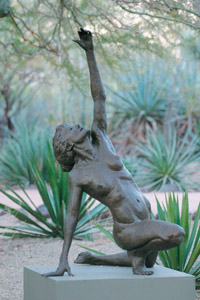|
||
     |
Peer Review ::
Open mike
Artists John, X’49, and Ruth, AB’44, Waddell make a new mold in the deserts of Northern Arizona.

Aspiration, 2001, bronze. Many of
Waddell’s models are dancers.
After serving in World War II, John Waddell returned to the Art Institute of Chicago, where in 1948 he met Ruth, also studying there after a year at the School of Social Service Administration. John shored up his credits with U of C psychology and sociology courses, developing a “humanistic” sensibility that continues to inform his work. Ruth and he married, settling in 1957 in Arizona, which, he says, still had “room for work,” including the outdoor sculpture pictured right. Now the couple runs a sprawling high-desert studio, where they sculpt, cast, carve, draw, paint, and dance, enjoying what John calls “a very rich and deep collaboration.”
Many hands: [Ruth and my] work is certainly different, so we may influence each other, but our collaboration is in our humanistic approach to the individuals that we come in contact with, whether they be our apprentices, the dancers we work with, or the people that come into our lives from the city. ... I think one of the wonderful things about our relationship is that Ruth really questions many of the things that I say or do, and it makes me think.
To each his own: I am interested in the beauty of what I call individual difference, the uniqueness of each person. And so [my figures] are not stylized figures. They are not abstracted. They are not academic, in the sense that the proportions are all different. ... [My experiences have] helped me to see human beings in their uniqueness, one from another, and to avoid the stereotypes that all cultures tend to fall into.
Still life: Usually I don’t tell the subjects how I want them to stand. I start them moving for me and I do some small figures first. Then I begin to see what’s characteristic of them at that time. I consider my work to be sort of fourth dimensional, in that it’s done over the period of a year or two, and, like all people, [the models] go through changes. I want that to be compressed in the sculpture, so I’m not just copying the surface or making a mold of the body, so to speak. Rather, I’m trying to get something of the essence of the figure.
Reading the future: [My pieces] come out such a deep place in me that I usually don’t know what they mean until long after I’ve finished them.
Keep the blood flowing: We’ve gone to a wonderful movement class for the last ten years, which has kept us somewhat limber. As a matter of fact, at 84 I am more limber than I was at 74—without a question. We didn’t start dancing with professional groups until our 50th wedding anniversary, which was five years ago. ... We love the idea of working with great dancers that are themselves artists. It’s all one for us.